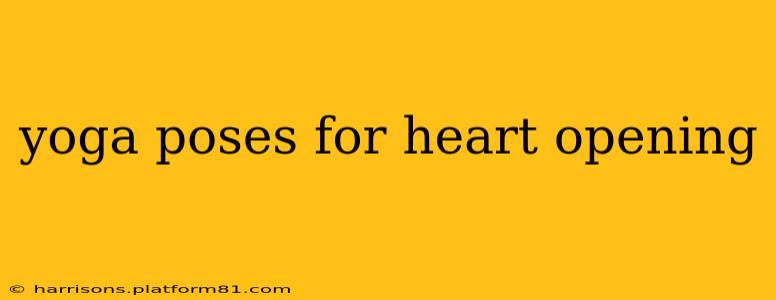Opening your heart, both literally and metaphorically, is a powerful practice in yoga. It’s not just about physical flexibility; it's about cultivating emotional resilience, self-compassion, and a deeper connection to yourself and others. This practice can alleviate stress, reduce anxiety, and foster a sense of overall well-being. This guide explores several yoga poses specifically designed to open the heart, along with modifications for different levels.
What are the Benefits of Heart Opening Poses?
Heart opening poses primarily target the chest, shoulders, and upper back, gently stretching and releasing tension in these areas. This physical release often corresponds to an emotional release, allowing for a sense of openness and vulnerability. Benefits extend beyond the physical:
- Reduced stress and anxiety: By releasing tension in the chest and shoulders, these poses can calm the nervous system.
- Improved posture: Strengthening the back muscles improves posture, leading to increased confidence and a sense of groundedness.
- Increased self-awareness: The focus required in these poses encourages mindfulness and self-reflection.
- Emotional release: Many find that heart opening poses help release emotional blockages and foster self-compassion.
- Enhanced breathing: Opening the chest allows for deeper, more fulfilling breaths, improving oxygen intake and overall energy levels.
Specific Yoga Poses for Opening the Heart
Here are some key poses, categorized by difficulty, to help you gently open your heart:
Beginner-Friendly Heart Openers
- Puppy Pose (Uttana Shishosana): This gentle backbend stretches the chest and shoulders. Start on your hands and knees, then walk your arms forward and drop your chest towards the mat, keeping your hips lifted. Hold for 5-10 breaths.
- Cobra Pose (Bhujangasana): A gentle backbend that strengthens the back muscles while opening the chest. Lie on your stomach, press into your hands, and lift your chest off the floor, keeping your shoulders relaxed. Hold for 5-10 breaths.
- Bridge Pose (Setu Bandha Sarvangasana): This pose opens the chest and gently stretches the shoulders and neck. Lie on your back with knees bent and feet flat on the floor. Lift your hips off the floor, pressing into your feet and shoulders. Hold for 5-10 breaths. You can place a block under your sacrum for support.
Intermediate Heart Openers
- Camel Pose (Ustrasana): A deeper backbend that requires more flexibility and strength. Kneel on your knees with your thighs perpendicular to the floor. Reach back and grasp your ankles, then gently arch your back. Keep your chest open and your gaze upward. Hold for 5-10 breaths. Use blocks under your hands if needed.
- Wheel Pose (Urdhva Dhanurasana): A powerful backbend that opens the heart and strengthens the entire body. This pose should only be attempted if you have sufficient flexibility and strength in your wrists, shoulders, and back.
- Bound Angle Pose (Baddha Konasana) with a Backbend: Start in Bound Angle Pose, then gently lean back, using your hands or blocks for support. This combines the hip opening of Bound Angle with a heart opening backbend.
Advanced Heart Openers
- King Pigeon Pose (Eka Pada Rajakapotasana): This advanced pose requires significant hip and shoulder flexibility. It opens the chest and provides a deep stretch in the hips. Proceed with caution and use blocks or props as needed.
- Bow Pose (Dhanurasana): A challenging backbend that requires significant flexibility and strength in the back and shoulders.
How Long Should I Hold Each Pose?
Hold each pose for 5-10 breaths, focusing on your breath and body sensations. Listen to your body and don't push yourself beyond your limits. Remember, consistency is key. Regular practice will gradually increase your flexibility and deepen your heart opening experience.
What if I Have Shoulder or Back Pain?
If you experience shoulder or back pain, it's crucial to listen to your body and avoid pushing yourself too hard. Use props such as blocks or blankets to support your body and modify the poses as needed. Consider working with a qualified yoga instructor who can guide you on modifications and ensure you're practicing safely.
Are There Any Contraindications for Heart Opening Poses?
Individuals with certain conditions, such as severe back problems, shoulder injuries, or high blood pressure, should consult a healthcare professional before practicing heart opening poses. Always listen to your body and stop if you experience any pain.
Can Heart Opening Poses Help with Emotional Healing?
Many people find that heart opening poses facilitate emotional release and healing. By releasing tension in the physical body, these poses can create space for emotional processing and self-compassion. However, it's important to remember that yoga is not a replacement for therapy and that seeking professional help is crucial for addressing deep-seated emotional issues.
By incorporating these poses into your regular yoga practice, you can nurture your physical and emotional well-being, creating space for greater self-love and compassion. Remember to listen to your body, practice with patience, and enjoy the journey of opening your heart.
